Marloes is situated five miles west of Milford Haven. It is part of the Pembrokeshire Coast National Park, and the parish has five miles of mainland coastline accessible throughout by the Pembrokeshire Coast Path. The parish, together with St Brides, constitutes the community of Marloes and St Brides. A War Memorial in the grounds of St. Peter’s Church, in the form of a plain granite cross, commemorates the memory of the men of the Parish who gave their lives during the Great War and a small plaque at the base of the memorial commemorates those who fell during World War Two. Inside the Church is a framed memorial scroll which commemorates the men of 304 (Polish) Squadron, Royal Air Force, who lost their lives whilst flying from RAF Dale during World War Two. This memorial is on a separate page (see RAF Dale War Memorial)
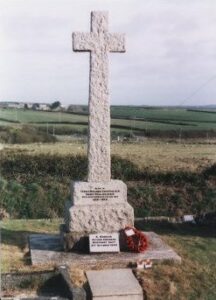
The Great War, 1914-1918
Jonathan Davies, Private, 26518, Welsh Regiment. Jonathan was born on 26 November 1897, the son of Thomas and Phyllis Davies, of Tree Hill Cottage, Murchin, Marloes. He enlisted at Haverfordwest into the 1st Battalion, Welsh Regiment, which was a regular Battalion stationed at India at the outbreak of war. They were recalled to Britain, and arrived at Plymouth on 22 December, before joining 84 Brigade, 28th Division. The Division formed in England between December 1914 and January 1915 from regular units returning from India, Singapore and Egypt. During January 1915 it moved to France, landing at Le Havre and moved to the Western Front, where it saw its first major action during the Second Battle of Ypres. Jonathan landed in France on 28 April 1915, as a replacement to the battered battalion, which had suffered severe casualties at Aubers Ridge. He was killed in action at Ypres on 25 May 1915, aged just 17. He has no known grave, and so he is remembered on the Ypres (Menin Gate) Memorial, Belgium.
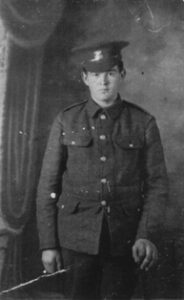
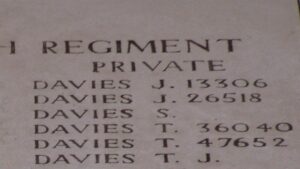
William Edward Devonald, Stoker 2nd Class, K/54833, Royal Navy. William was born at Marloes on 13 May 1892. He married Mary Griffiths at Haverfordwest in 1912, and the couple set up home at The Cottage, Marloes, where William served as the local Police Constable. William enlisted into the Royal Navy on 31 October 1918 and was posted to HMS Vivid, the Shore Establishment at Devonport. William was taken ill soon after enlisting and died of influenza and pneumonia in Plymouth Hospital, Devon on 9 November 1918, aged 26. He is buried at Marloes (St. Peter) Churchyard. Mary later moved to 51, Priory Street, Carmarthen.
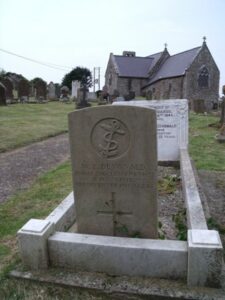
The Honorable Cecil Edwardes, Captain, Scottish Horse & Tank Corps. Cecil was born on 31 May 1876, the son of William Edwardes, 4th Baron Kensington and his wife Grace Elizabeth. The family had a residence at St. Bride’s Hill, Pembrokeshire, and Cecil lived here for long periods with his wife, Marie Louise Edwardes (nee Martin) of Canada. Cecil had served with the Royal Navy, but by the time of the war had been commissioned into the Scottish Horse. During 1916 Cecil had transferred to the newly formed Tank Corps. He served with ‘H’ Battalion, which took part in the opening of the Battle of Cambrai on 20 November 1917. Six tanks from H Battalion took Fontaine, four miles from Cambrai, bursting through the Cantaing Line and getting into the village half an hour before infantry of the Seaforth Highlanders and Argyll and Sutherland Highlanders from the 51st Division followed up and occupied it. Cecil was killed when his tank was knocked out during the initial advance that day. He was 41 years old, and has no known grave, and so he is remembered on the Cambrai Memorial, Louverval.
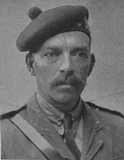
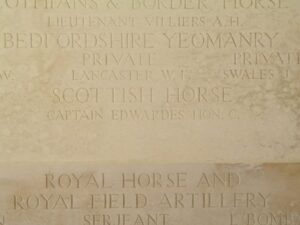
William Thomas Edwards, Sergeant, 4003, Kings Own Scottish Borderers. William was born at Marloes in 1868, the son of Thomas and Eliza Edwards. He had married prior to the war, and by 1914 lived with his wife Margaret Nicholson Edwards, at 18, Harbour Road, Wigtown. William enlisted there into the 1/5th Battalion, Kings Own Scottish Borderers, which formed at Dumfries during August 1914, as part of the South Scottish Brigade, Lowland Division. They moved to Camp at Bannockburn, near Stirling, where they joined 155 Brigade, 52nd Division. Initially assigned to the defence of the Scottish coast, the Division moved to Gallipoli (less two of its artillery Brigades) arriving there by early July 1915. While moving from Scotland, the Division lost 210 officers and men killed, and another 224 injured, in a train crash near Gretna that involved the 1/7th Battalion, the Royal Scots. William was killed in action at Gallipoli on 12 July 1915. He was 46 years old, and is remembered on the Helles Memorial, Gallipoli.
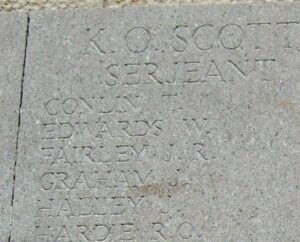
David Evans, Guardsman, 15047, Grenadier Guards. David was born at St. Brides, the son of David and Alice Evans. He had moved to London prior to the war, living with his wife, Emma H. Evans, at 13, Havelock Road, West Kensington, London. He enlisted at Cardiff into the 2nd Battalion, Grenadier Guards, which was at Chelsea at the outbreak of war. They quickly joined the 4th (Guards) Brigade, 2nd Division, and on 15 August 1914 landed at Havre, before moving to positions near Mons, as part of the BEF. They fought at the Battle of Mons, and retreating southwards, fought at the Affair of Landrecies, the Rearguard Actions of Villers-Cotterets, and at the Battle of the Marne where the German offensive was stopped. The Germans retreated north, and the BEF met them, fighting at the Battle of the Aisne. The division was then moved to Flanders, where they fought at the First Battle of Ypres, when the German sweep through Flanders was stopped, and remained there throughout the first winter of the war. David was wounded in France, probably at Ypres, and had been transported back to Britain for treatment. He died here on 23 November 1914 aged 23, and is buried at Cambridge City Cemetery.
John Thomas Folland, Private, 27458, Welsh Regiment. John was the son of James and Ellen Folland, of Murchin, Marloes, and the brother of William (below). He enlisted at Milford Haven into the 1st Battalion, Welsh Regiment, which was a regular Battalion stationed at India at the outbreak of war. They were recalled to Britain, and arrived at Plymouth on 22 December, before joining 84 Brigade, 28th Division. The Division formed in England between December 1914 and January 1915 from regular units returning from India, Singapore and Egypt. During January 1915 it moved to France, landing at Le Havre and moved to the Western Front, where it saw its first major action during the Second Battle of Ypres. Following serious casualties at Ypres, a Composite Brigade was formed, composing of the 2nd Battalion, the Buffs, 2nd Battalion, the Cheshire’s, 1st Battalion, the Welsh, and 1st Battalion, the York and Lancaster. It was dissolved on 19 May 1915, and the formation assumed its normal configuration, taking part in the Battle of Loos. John was killed in action at Loos on 2 October 1915, aged 29. He has no known grave, and so is remembered on the Loos Memorial, France.
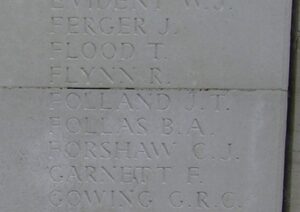
William Edward Folland, Corporal, 8501, Welsh Regiment. William was the son of James and Ellen Folland, of Murchin, Marloes, and the brother of John (above). William enlisted at Haverfordwest prior to 1911 into the 2nd Battalion, Welsh Regiment. At the outbreak of war the battalion moved to France attached to 3 Brigade, 1st Division. The Division had been one of the first to arrive in France, fighting at the Battle of Mons, and taking part in the retreat to the Marne, where the Germans were stopped. They then fought at the Aisne, and at Chivy, before being moved north to Ypres. Here they fought at the First Battle of Ypres, where they again stopped the German Offensive, before wintering in Flanders. The following year saw them in action again at the Battle of Aubers, before moving South to Loos, where they fought during the Battle of Loos, and the action at the Hohenzollern redoubt. William was killed in action at Loos, a week before his brother John, on 25 September 1915. He was 31 years old, and is remembered on the Loos Memorial, France.
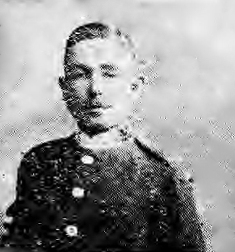
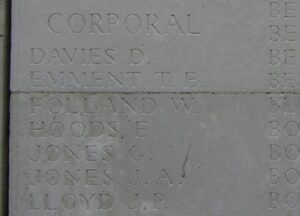
George Henry Griffiths, Private, 19475, Welsh Regiment. George was the son of James and Martha Griffiths, of Marloes, and he enlisted at Milford Haven into the 1st Battalion, Welsh Regiment, which was at India at the outbreak of war. They were recalled to Britain, and arrived at Plymouth on 22 December, before joining 84 Brigade, 28th Division. The Division formed in England between December 1914 and January 1915 from regular units returning from India, Singapore and Egypt. During January 1915 it moved to France, landing at Le Havre and moved to the Western Front, where it saw its first major action during the Second Battle of Ypres. George was killed in action at Ypres on 25 May 1915. He was 26 years old, and has no known grave, and so he is remembered on the Ypres (Menin Gate) Memorial.
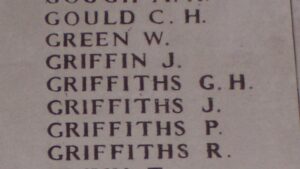
Ewart Edmund Lewis, MM, Sergeant, 91747, Royal Field Artillery. Ewart, known locally as Ted, was the son of John and Frances Maude Lewis. His parents were from Marloes, but Ted had been born while they were living at Cardiff. His father died when he was young and his mother married William Ernest Hier, of Marloes, in 1896. Ted worked at Cardiff prior to the war and enlisted at Newport into the Royal Field Artillery. He had reportedly served in Gallipoli before being posted to France, joining C Battery, 177th Brigade, Royal Field Artillery, which was attached to the 16th (Irish) Division. Ted was obviously a brave man, as he was mentioned in despatches twice during the war, as well as being awarded the Military Medal, probably for the Battle of Messines. He was killed in action during the opening day of the German spring offensive, on 21 March 1918, aged 26, and is commemorated on the Pozières Memorial, France.
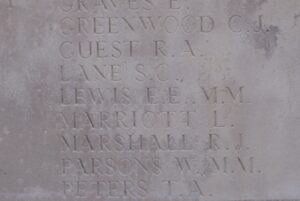
William Benjamin Lewis, Sergeant, G/25075, Middlesex Regiment. William was born at Marloes in 1879, the son of George D. and Mary A. Lewis. The family later resided at Prospect Place, Letterston. William arrived in France during 1916, and served with the 13th Battalion, Middlesex Regiment. The battalion was attached to 73 Brigade, 24th Division, and had suffered heavy casualties at Loos in September 1915. In 1916 they took part in the Battle of the Somme, before moving north of Arras in early 1917. In April and May 1917 they fought at the Battle of Vimy, alongside the Canadian Corps, and in June they moved to positions south of Ypres, where they fought during the Battle of Messines. After the successful capture of Messines Ridge, the Division moved further north, and fought at the Battles of Pilckem and Langemarck during Third Ypres. The Division then moved to positions north of St. Quentin over the winter of 1917/18, and were here when the Germans launched their Offensive on 21 March 1918, fighting a famous defence of the village of Le Verguier. William was killed here on 28 March 1918, aged 38. He is commemorated on the Pozières Memorial, France.
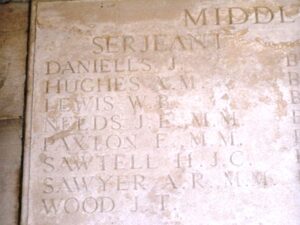
Albert Ernest Owens, Private, 53918, Welsh Regiment. Albert was the son of James and Mary Owen, of Marloes. He was the manager of the Star Tea Companyin Fishguard prior to enlisting into the army. He was posted to the 15th Battalion, Welsh Regiment (Carmarthen Pals), which was attached to 114 Brigade, 38th (Welsh) Division. The Division had landed in France during December 1915 and had spent their first winter in the trenches near Armentieres. In June they marched south to the Somme, where they were tasked with the capture of Mametz Wood. The attack on the wood began on 7 July, but met with fierce resistance, and it took a second assault, which began on 10 July, to clear the wood. The Division suffered terrible casualties at Mametz, and were taken out of the line, and moved to Ypres to rebuild. Albert was wounded at Ypres, probably during the battalions trench raid on the Morteldje Salient on 29 April 1917, and died of his wounds on 30 April 1917. He was 30 years old, and is buried at Ferme-Olivier Cemetery, Belgium.
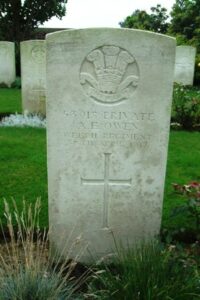
Albert Edward Pearce, Sapper, 67333, Royal Engineers. Albert was born at Wandsworth in 1891, the son of Edward and Frances Pearce. Prior to the war he had moved to Marloes, and married Eunice Edwards there in 1913. Albert enlisted at Haverfordwest into the Royal Engineers, and served with their 151st Field Company, which was attached to the 38th Welsh Division. The Division had landed in France during December 1915 and had spent their first winter in the trenches near Armentieres. In June they marched south to the Somme, where they were tasked with the capture of Mametz Wood. The attack on the wood began on 7 July, but met with fierce resistance, and it took until 14 July to clear the wood. Albert was wounded at Mametz, and evacuated to the Casualty Clearing Station at Heilly in the Somme Valley, where he died of wounds on 14 July 1916. He was 25 years old, and is buried there, at Heilly Station Cemetery, Mericourt-L’Abbe.
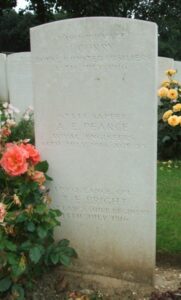
World War Two, 1939-1945
Francis Cyril Priter Buttress, Chief Petty Officer, D/J. 15809, Royal Navy. Francis was born on 11 June 1896, the son of John and Sarah Anne Buttress. He enlisted into the Royal Navy on 1 February 1912, and served continually throughout World War 1 through to World War 2, when he served at HMS Goldcrest, the RNAS base at Dale. Francis was killed during a road accident on 19 June 1944, aged 48, and is buried at Marloes (St. Peter) Churchyard.
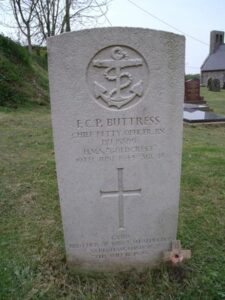
Thomas Benjamin Griffiths, Marine, PLY/X 316, Royal Marines. Thomas was the son of Benjamin and Ann Griffiths, of Marloes. He served with the Royal Marines aboard HMS Hermes. She had been the first purpose built aircraft carrier in the world, after having been launched in 1919. In February 1941, Hermes supported Commonwealth forces in Italian Somaliland during the East African Campaign, and during the Anglo-Iraqi War. She then patrolled the Indian Ocean, before joining the Eastern Fleet in Ceylon. After the raid on Colombo on 5 April by the Japanese, Hermes was sent to Trincomalee, but had left the harbour when the Japanese attacked it on 9 April. She was spotted by a Japanese scout plane and attacked by dive bombers shortly afterwards. Hermes and her escorting destroyer were quickly sunk by the Japanese. Thomas was one of 307 men from Hermes who were lost in the attack on 9 April 1942. He was 32 years old, and is commemorated on the Plymouth Naval Memorial, Devon.
Sydney Morgans, Second Engineer, Fishing Fleet. Sydney was the son of John and Alice Morgans, and the husband of Martha Morgans, of Marloes. He was a fisherman, and served aboard the Fishing Vessel Grenada, a Hull registered trawler. On 3 October 1945, Grenada struck a German mine off the Old Head of Kinsale, and sank with the loss of all but one of her crew. Sydney was 51 years old, and is commemorated on the Tower Hill Memorial, London.
Sidney Phillips, Stoker, LT/KX 124640, Royal Naval Patrol Service. Sidney was the son of Thomas and Lucy Phillips, of Marloes, and the husband of Winifred Phillips, of St. Ishmaels. He served with the Royal Naval patrol Service aboard HM Trawler Fortuna. Fortuna was used as a Patrol Vessel. Sidney was killed when Fortuna was bombed by German aircraft off St Abbs Head on 5 April 1941. He is buried at Berwick-Upon-Tweed Cemetery.